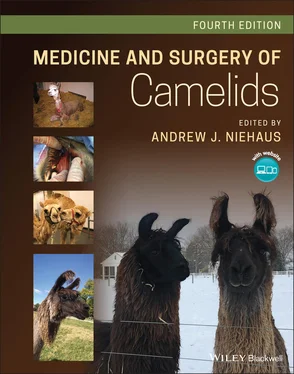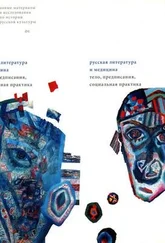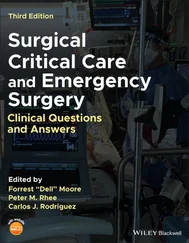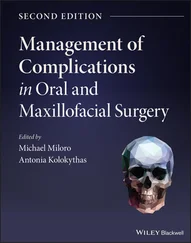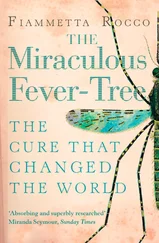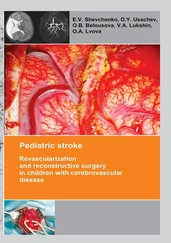8 Chapter 8Table 8.1 Growth of the llama.
9 Chapter 9Table 9.1 Definition of terms used to describe hair, wool, and camelid fiber...Table 9.2 Milk composition (as fed).
10 Chapter 10Table 10.1 Complications following fracture repair in SACs.Table 10.2 Grades of patellar luxation with their respective description.
11 Chapter 12Table 12.1 Dental formulas of camelids and ruminants.Table 12.2 Eruption of SAC and Camel teeth.Table 12.3 Comparison of ruminant and camelid stomach compartments.Table 12.4 Selected biochemical parameters and blood gases from SACs with hy...
12 Chapter 13Table 13.1 Comparison of T 3and T 4values from various studies.
13 Chapter 14Table 14.1 CBC reference intervals for adult llamas, alpacas, and camels.Table 14.2 Antigen expression on selected leukocyte subsets a.Table 14.3 Biochemistry reference intervals for adult llamas, alpacas, and c...Table 14.4 Peritoneal and pleural fluid analysis in clinically healthy adult...Table 14.5 CSF analysis in clinically healthy adult llamas and dromedary cam...
14 Chapter 16Table 16.1 Mean testicular size (length × transverse axis) and weight in lla...Table 16.2 Semen characteristics of llamas and alpacas [17].Table 16.3 Measurements of female SAC reproductive organs.Table 16.4 Causes of fetal and maternal dystocia.Table 16.5 Llama reproduction examination – female.Table 16.6 Llama reproduction examination – male.Table 16.7 Sperm analysis of 22 alpacas and 8 llamas.Table 16.8 Checklist for a female intended as a breeder.Table 16.9 Checklist for a male intended for a breeder.
15 Chapter 17Table 17.1 Normal camelid urinalysis.Table 17.2 Urinalysis in selected diseases.Table 17.3 Composition of urinary calculi recovered from llamas at the Veter...
16 Chapter 20Table 20.1 Cria scoring system .Table 20.2 Camelid birthing record.Table 20.3 Colostrum composition (as fed).Table 20.4 Causes of failure of passive transfer of immunoglobulins.Table 20.5 Bottle baby feeding schedule.Table 20.6 Milk composition (as fed) [52].Table 20.7 Some companies manufacturing lamb and kid milk replacers in the U...Table 20.8 Composition of Land O′ Lakes milk replacers and llama milk.Table 20.9 Cria Weight schedule.
17 Chapter 21Table 21.1 Congenital conditions in lamoids.Table 21.2 Poisonous plants with teratogenic effects in livestock.Table 21.3 Homologies of male and female reproductive systems.
18 Chapter 22Table 22.1 Heavy metal poisoning in camelids.Table 22.2 Poisonous plants that may affect llamas on trek. Table 22.3Additional plants that may cause poisoning in SACs.Table 22.4 Poisonous plants that may affect camels.
19 Chapter 23Table 23.1 Sedation.Table 23.2 Darting combinations.
1 Chapter 1 Figure 1.1 Dromedary camel cow nursing her calf (). Figure 1.2 Bactrian camel. Figure 1.3 (a) Wild Bactrian camel from the Gobi Desert in Mongolia. (b) Mul... Figure 1.4 Guanaco (). Figure 1.5 Geographic distribution of undomesticated SAC's [14, 15]. Figure 1.6 Peruvian vicuña. Note the long bib hair on their ventral chest (... Figure 1.7 Argentine vicuña. Argentine vicuña's have short bib hair. Figure 1.8 Heavily fibered huacaya alpaca. Figure 1.9 Huacaya alpaca female. Figure 1.10 Suri alpaca. Figure 1.11 Wooly‐necked llama. In Peru these animals are called “ch'aku” in... Figure 1.12 Llama. Figure 1.13 Suggested evolution of recent artiodactylids. Figure 1.14 Skeletons of various prehistoric camelids removed from the La Br... Figure 1.15 Native distribution of camels in Africa and Asia. Figure 1.16 Historic and current distribution of SAC in South America. Figure 1.17 Dromedary camel as a riding camel for tourists. Figure 1.18 Dromedary camels as draft animals. Figure 1.19 Racing dromedary camels in the United Arab Emirates. Figure 1.20 Showing alpacas. Figure 1.21 Packing llamas on trek (). Figure 1.22 Llamas can be used as guard animals to protect smaller, more vul...
2 Chapter 2 Figure 2.1 (a) Illustration of the stance of a relaxed alpaca. (b) Illustrat... Figure 2.2 This handler is standing in a pen with an alpaca in a non‐threate... Figure 2.3 Handler is holding steadily as the llama pulls. This technique wi... Figure 2.4 Neutral Rope. There is no tension in the lead rope and the llama ... Figure 2.5 Drawing illustrating how the long neck of South American camelids... Figure 2.6 This photo shows a nicely packed pen. The animals have room to mo... Figure 2.7 Drawing illustrating a setup for corralling animals calmly into a... Figure 2.8 An ideal catch pen. This pen is 8 × 8 ft. square. If the area is ... Figure 2.9 “Mini” or “half” catch pen. If the animals are small or you don't... Figure 2.10 Schematic of the Camelidynamics handling facility. This system c... Figure 2.11 Llama contained in a chute. This chute has solid sides and a bar... Figure 2.12 Demonstration of catching an alpaca with a “midline catch.” The ... Figure 2.13 Demonstration of control of an alpaca with a “midline catch.” Th... Figure 2.14 Demonstration of head control with the “bracelet” technique. The... Figure 2.15 Demonstration of application of the handler helper to an alpaca ... Figure 2.16 Alpaca with the handler helper in place. Figure 2.17 Application of a neck wrap to an alpaca to help keep the animal ... Figure 2.18 Alpaca with neck wrap in place. Figure 2.19 A holster on the lower leg, can be useful when trimming feet to ... Figure 2.20 Preparing to pick up the left front foot. The handler is using h... Figure 2.21 The handler has now moved the left hand from the midline to the ... Figure 2.22 On the opposite side, the hands are switched so that the handler... Figure 2.23 The handler is managing the animal's balance using the right han... Figure 2.24 The handler uses the left hand on the back to ask the llama to s... Figure 2.25 The handler now moves the left hand off the back and uses it to ... Figure 2.26 Trimming the toenail is best done by trimming small pieces of th... Figure 2.27 Trimming nails inside a trailer is much easier with difficult an... Figure 2.28 Photo demonstrating trimming of an alpaca's toenails while it is... Figure 2.29 Illustration of proper location for giving a subcutaneous and in... Figure 2.30 Photo illustrating working in a packed pen. One handler is balan... Figure 2.31 The handler is giving an injection solo without restraint using ... Figure 2.32 This photo illustrates keeping the alpaca near and parallel to t... Figure 2.33 Injections can be given while multiple animals are contained in ... Figure 2.34 In this photo, a helper is balancing the animal for an IM inject... Figure 2.35 This photo illustrates using a handler helper, along with a bala... Figure 2.36 An intramuscular injection into the triceps muscle is done easil... Figure 2.37 This animal is held forward in the shoulder supports by virtue o... Figure 2.38 This is a brilliant technique from a handling perspective. It al... Figure 2.39 This photo illustrates performing a rectal ultrasound using bala... Figure 2.40 Llamas and alpacas often do not object to being touched even aro... Figure 2.41 An olive‐tip dosing syringe. Figure 2.42 (a) The handler is using the right arm with the elbow high up on... Figure 2.43 Using the halter to balance a llama's head to administer oral me... Figure 2.44 Working with the ears helps facilitate easier haltering as well ... Figure 2.45 Earring humanely requires that the ear be squeezed but never twi... Figure 2.46 The camelid skull clearly shows there is not much bone forward o... Figure 2.47 When the noseband is not on bone, it can easily compress the car... Figure 2.48 This halter fits properly; the nose band is adequately sized to ... Figure 2.49 This alpaca is wearing a halter that is too far forward on the n... Figure 2.50 This llama is wearing a halter that looks like it fits but, in f... Figure 2.51 This halter fits. You can see that there is slack in the nose ba... Figure 2.52 A handler helper is a great way to facilitate catching by people... Figure 2.53 Male llamas fighting. Figure 2.54 Male alpacas fighting. Figure 2.55 This photo demonstrates a respectful and safe interaction betwee... Figure 2.56 This photo demonstrates an appropriate interaction in the field.... Figure 2.57 This camel was previously aggressive when fed. The author taught... Figure 2.58 By using a pouch to secure the food, a clicker and food reinforc... Figure 2.59 Children frequently interact inappropriately with young crias. W...
Читать дальше
